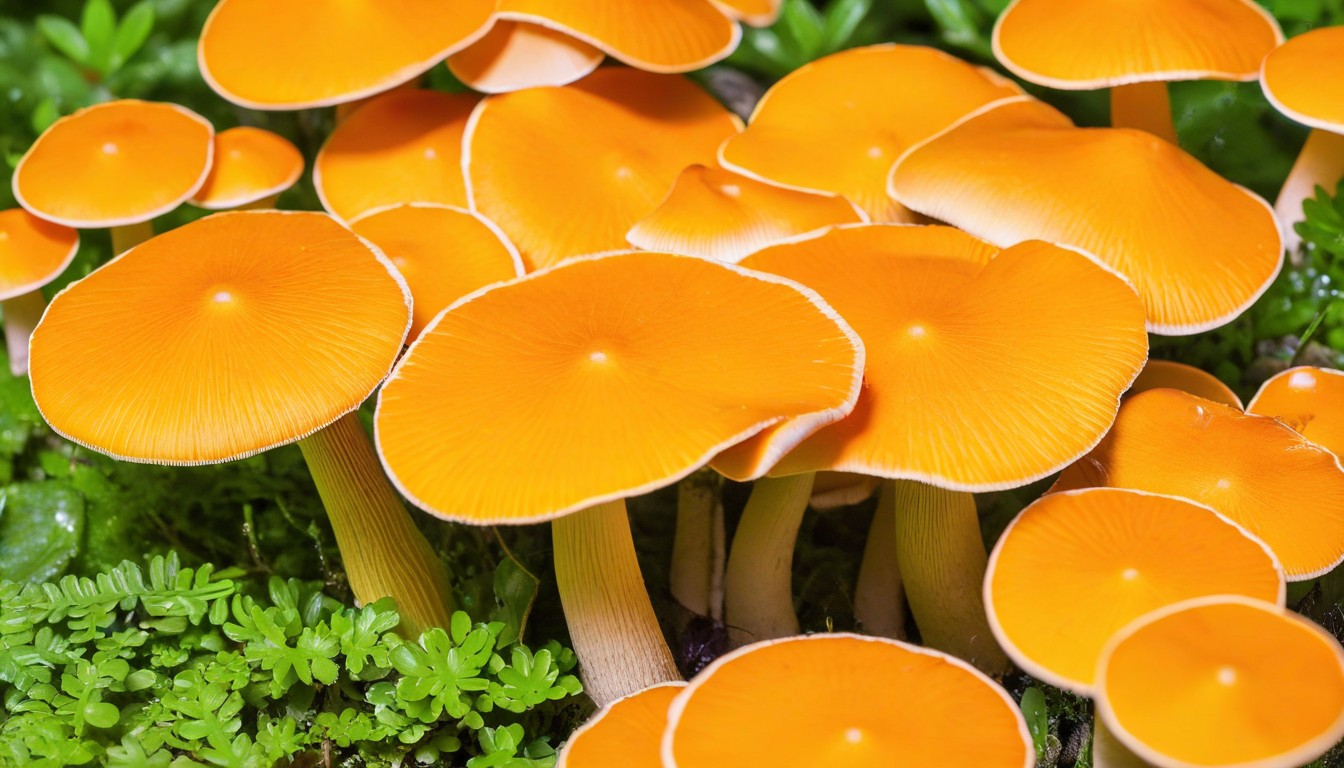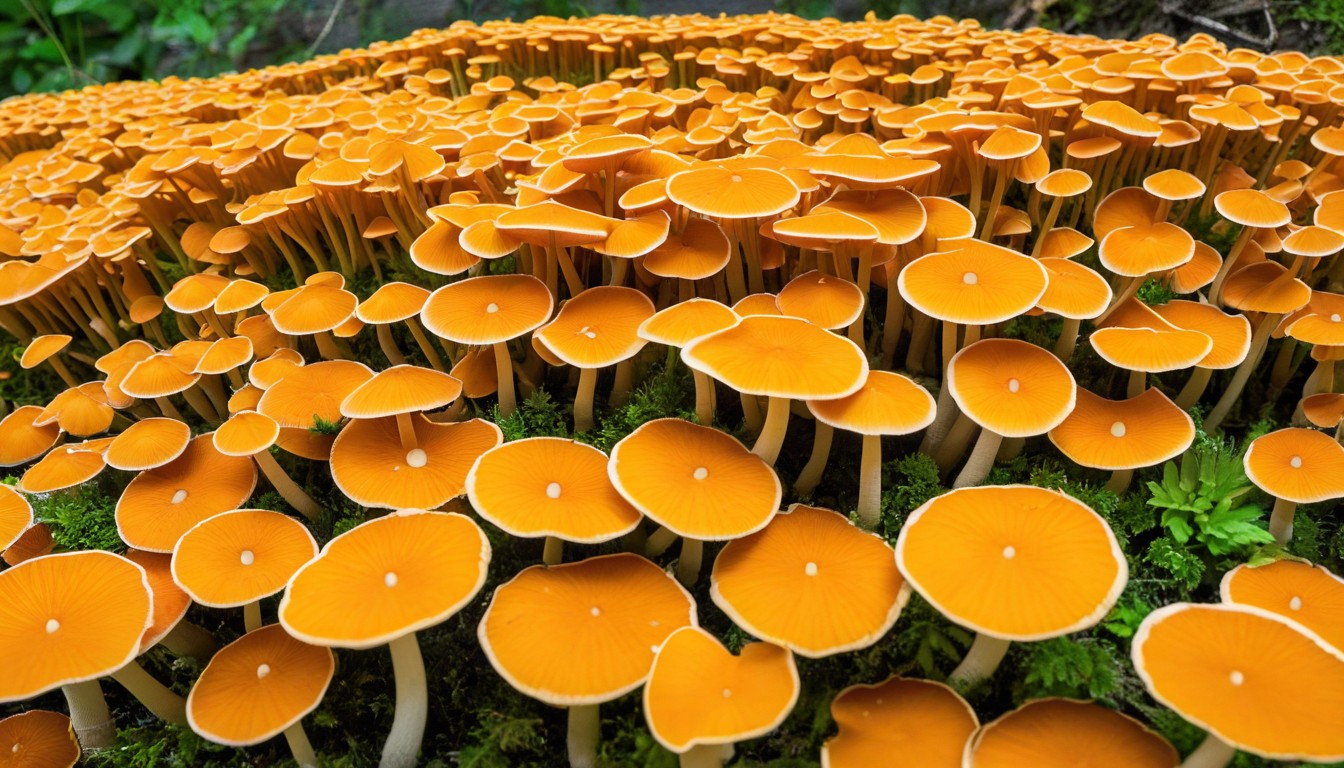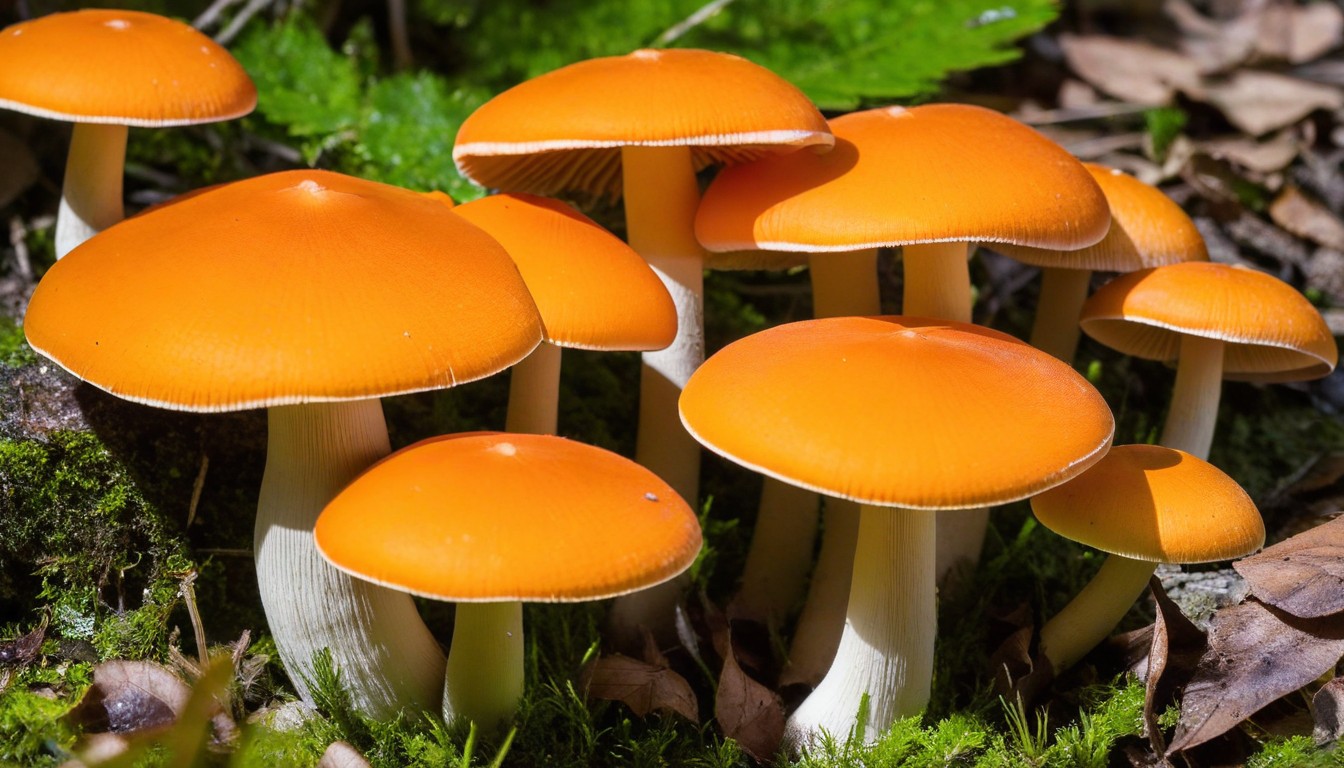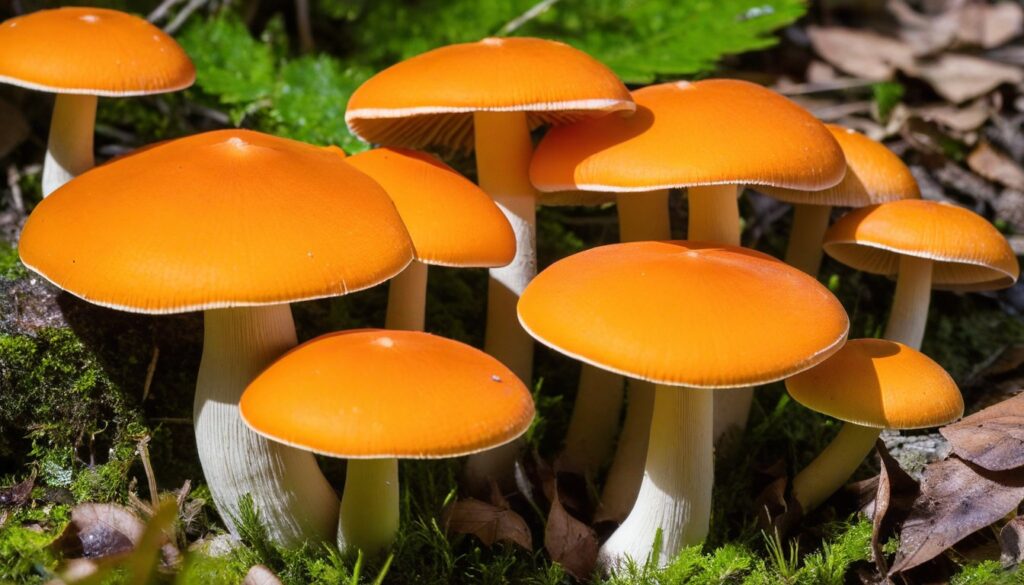Welcome to our comprehensive guide on identifying flat orange mushrooms. Whether you’re a seasoned mushroom hunter or a nature enthusiast looking to learn more about fungi, this guide will provide you with all the necessary information to discover and learn about these unique mushrooms. Flat orange mushrooms can be found in various habitats and regions, and identification can be challenging for beginners. But with this guide, you’ll be well-prepared to identify them confidently in the wild.
Key Takeaways:
- Flat orange mushrooms are a unique and fascinating type of fungi.
- Identification can be challenging, but this guide provides all the necessary information.
- Knowing the key characteristics and preferred habitats can make identification much easier.
- It’s important to be aware of look-alike species and take necessary safety precautions when foraging.
- Flat orange mushrooms have potential medicinal benefits and contributing to their conservation efforts is crucial.
Characteristics of Flat Orange Mushrooms
Flat orange mushrooms are distinct from their counterparts in the fungal kingdom by their unique characteristics.
Size and Shape
Flat orange mushrooms are typically small, ranging from 1-6 cm in diameter. Their cap has a flat or slightly convex shape, with a downturned margin. The stem is thin, and it has a flaring basal disk.
Color
Their vibrant orange color sets them apart from other types of mushrooms in the wild. The cap is a bright orange, while the gills and stem are paler with a yellowish hue.
Cap Texture
Flat orange mushrooms have a smooth and dry cap texture, which allows them to withstand harsh weather conditions like heavy rainfall and strong winds. The cap may also feature radial grooves that radiate from the center of the cap to the edge.
Scent and Taste
Flat orange mushrooms have a mild taste and a pleasant smell, which can be described as fruity or earthy. However, it’s essential to note that not all flat orange mushrooms are edible, and some may be toxic or contain harmful chemicals.
Spores
The spores of flat orange mushrooms vary from pale yellow to brownish-orange when viewed under a microscope.
Common Species of Flat Orange Mushrooms

Flat orange mushrooms come in a variety of species, each with its distinct features and preferred habitats. Here are some of the most commonly found species:
|
Species Name |
Scientific Name |
Habitat |
Characteristics |
|---|---|---|---|
|
Orange Mycena |
Mycena leptocephala |
Deciduous forests, grasslands |
Slimy cap, orange to red color |
|
Flaming Waxcap |
Hygrocybe aurantiaca |
Grasslands |
Flame-orange cap, smooth and dry surface |
|
Ocher Knight |
Tricholomopsis ochracea |
Coniferous forests, grasslands |
Yellow-orange cap, gills that run down the stalk |
|
Buff Bighead |
Calocybe carnea |
Grasslands |
Pinkish-orange cap, convex shape |
If you’re exploring a forest or grassy area and come across one of these species of flat orange mushrooms, take time to observe and appreciate their unique characteristics. However, it’s important to note that some look-alike mushrooms can be dangerous and potentially deadly. Always consult a reliable guide or seek the advice of an experienced mycologist before consuming any mushrooms.
Habitat and Growing Conditions

Flat orange mushrooms can be found in a variety of habitats, including forests, woodlands, and grasslands. They are also known to grow on decaying wood and fallen trees. These mushrooms thrive in areas with consistent moisture and shade, making them more prevalent during the rainy season. They prefer to grow in well-drained soils and are often found around the bases of trees.
When searching for flat orange mushrooms, pay attention to the growing conditions of the surrounding area. Look for areas with a good balance of moisture and sunlight, and avoid heavily polluted or disturbed areas. Remember to always leave enough mushrooms behind for other creatures, and never harvest more than you need.
Identifying Look-Alikes
Although flat orange mushrooms have distinct characteristics, it is essential to distinguish them from similar-looking mushrooms. While some look-alike species may be harmless, others can be poisonous, making it vital to know the difference.
One common mushroom that resembles flat orange mushrooms is the Jack-o’-lantern. These mushrooms feature gills that are similar in shape and orange in color but grow on wood instead of the ground. To differentiate between the two, examine the habitat and look for features such as a stem or a partial veil.
The Golden Chanterelle, a popular wild edible, also shares some similarities with flat orange mushrooms in terms of color and shape. However, Chanterelles are convex and fleshy with thick and wavy stems instead of flat and thin, like flat orange mushrooms.
Another similar-looking mushroom is the Sulphur Tuft, which also has the same vibrant orange hue but has gills that change from yellow to brown as the mushroom matures. These mushrooms also have a bitter taste and a distinct odor, unlike the pleasant fruity aroma of flat orange mushrooms.
To avoid any confusion, it is best to examine the physical characteristics of mushrooms and their habitat carefully. If you are unsure, seek guidance from an experienced forager before consuming any wild mushrooms.
Tip: When in doubt, always leave a mushroom in the wild. Only consume mushrooms confidently identified as safe and avoid those with any uncertainty in their identification.
Edibility and Safety

While flat orange mushrooms have a distinct appearance, it’s crucial to understand their edibility before consuming them. Some species of fungi can cause severe health problems, making it important to know which mushrooms are safe for consumption.
It’s best to avoid consuming wild mushrooms if you don’t have experience in identifying them, and it’s vital to note that even trained experts can misidentify some mushroom species.
For those who are confident in their identification, some species of flat orange mushrooms are edible and are often consumed across the world and known for their delicious taste. However, improper preparation of mushrooms can lead to digestive problems or even poisoning.
If you’re planning on foraging for flat orange mushrooms, it’s recommended that you go with an experienced guide and equip yourself with reliable field manuals. Always remember the golden rule: if you’re not 100% sure a mushroom is edible, don’t consume it!
Note: Some species of flat orange mushrooms contain toxins that can cause nausea, vomiting, and diarrhea, while some can lead to severe organ damage and even death if consumed. If you suspect mushroom poisoning, seek emergency medical attention immediately.
Medicinal Benefits and Folklore
Flat orange mushrooms not only captivate our eyes, but they also pique our interests in their medicinal properties. The truth is, these mushrooms have been used for centuries in traditional medicine.
According to folklore, strewing flat orange mushrooms around the house can bring good luck and ward off evil spirits. In addition, it was believed that the fiery appearance of these mushrooms could ignite passion and desire.
Recent research has shown that flat orange mushrooms may possess potent antioxidant and anti-inflammatory properties. They are also a rich source of polysaccharides and beta-glucans, which have immune-boosting effects.
|
Medicinal Benefits |
Folklore |
|---|---|
|
Fights inflammation |
Brings good luck |
|
Boosts the immune system |
Wards off evil spirits |
|
Promotes cardiovascular health |
Ignites passion and desire |
It’s important to note that some mushrooms can be toxic, so it’s crucial to consult with a qualified medical professional before using any type of mushroom for medicinal purposes.
As we continue to unearth the potential benefits of flat orange mushrooms, we can’t help but marvel at their wondrous folklore and healing properties.
Cultivation and Conservation

Flat orange mushrooms are unique specimens that require specific growing conditions. While they can grow in various habitats, they thrive in decaying wood and grasslands. If you’re interested in cultivating these mushrooms, it’s crucial to use sustainable techniques that protect their natural habitats.
One popular technique for cultivating flat orange mushrooms is through spore prints. The spore print of a mushroom can help identify the species and allow you to grow them from scratch. However, it’s important to note that cultivating mushrooms requires an understanding of proper growing conditions and techniques.
Conservation efforts are essential to protect the habitats where flat orange mushrooms grow. Fungi play an essential role in ecosystems, and their loss can have a significant impact. By preserving natural habitats and educating others about the importance of conservation, we can ensure that future generations can enjoy the beauty and benefits of these unique mushrooms.
Comparison of Cultivation Techniques
|
Technique |
Advantages |
Disadvantages |
|---|---|---|
|
Growing from Spore Prints |
Allows for the cultivation of a specific species |
Requires patience and technical knowledge |
|
Cloning |
Allows for the cultivation of mushrooms with desirable traits |
Requires the use of sterile equipment and knowledge of laboratory techniques |
|
Wild Harvesting |
Natural and sustainable |
Dependent on environmental factors |
Remember, when cultivating flat orange mushrooms, always prioritize sustainable techniques and the protection of natural habitats.
Conclusion
Now that you’ve reached the end of our flat orange mushroom identification guide, we hope you feel equipped to identify and appreciate these unique fungi. Remember to take caution when foraging and always prioritize safety when it comes to consuming mushrooms.
Whether you’re a seasoned forager or a beginner, exploring the world of mushrooms can lead to endless discoveries and opportunities for connection with nature. So grab your basket and head out into the woods – happy hunting!
FAQ
How can I identify flat orange mushrooms?
Flat orange mushrooms can be identified by their distinct characteristics such as their flattened caps, vibrant orange color, and often growing in clusters. It’s also essential to observe their habitat and growing conditions to ensure accurate identification.
Are all flat orange mushrooms edible?
While some species of flat orange mushrooms are edible and safe to consume, it is important to exercise caution and consult an expert when foraging for mushrooms. There are also toxic look-alike species that resemble flat orange mushrooms, so proper identification is crucial for safety.
Can flat orange mushrooms be cultivated in home gardens?
Yes, flat orange mushrooms can be cultivated in controlled environments such as home gardens. However, it requires specific techniques and knowledge to provide the optimal growing conditions. It is recommended to research and follow expert guidelines for successful cultivation.
Are there any medicinal benefits associated with flat orange mushrooms?
Yes, flat orange mushrooms have been traditionally used in some cultures for their potential medicinal properties. However, it is important to note that further scientific research is needed to fully understand and validate these claims. It is always best to consult a healthcare professional before using any mushroom for medicinal purposes.
Where can I find flat orange mushrooms?
Flat orange mushrooms can be found in various habitats such as forests, grasslands, and decaying wood. They tend to prefer damp and humid environments. It is recommended to explore these habitats during the appropriate season and with proper knowledge of their characteristics for successful mushroom spotting.
Are there any poisonous mushrooms that resemble flat orange mushrooms?
Yes, there are poisonous mushrooms that resemble flat orange mushrooms. It is crucial to be aware of their look-alike species and carefully examine the distinguishing features to ensure proper identification. When in doubt, it is always best to consult an expert or avoid consuming mushrooms altogether to prioritize safety.

